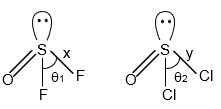Select the correct option regarding following figure:

Due to large size of Cl it has more angle and more bond length.
This question involves the concept of refraction and critical angle in optics. The figure shows two light rays entering a medium (likely from air to a denser medium) at different angles. The angles θ₁ and θ₂ are the angles of incidence, and x and y are the angles of refraction. The critical angle is the angle of incidence for which the angle of refraction is 90°.
Step 1: Understand the relationship between angle of incidence and angle of refraction using Snell's Law. Snell's Law states:
where n₁ and n₂ are the refractive indices of the two media, θᵢ is the angle of incidence, and θᵣ is the angle of refraction.
Step 2: For a ray going from air (n₁ ≈ 1) to a denser medium (n₂ > 1), sin(θᵣ) = (n₁/n₂) sin(θᵢ). Since n₁/n₂ < 1, θᵣ < θᵢ. So, the refracted ray bends towards the normal.
Step 3: The critical angle (θ_c) is given by:
(when n₂ < n₁, for total internal reflection).
In this case, since the ray is entering a denser medium, critical angle is not directly applicable for refraction, but it is important for understanding the limits.
Step 4: In the figure, one ray has a larger angle of incidence (θ₂) and is refracted at 90°, meaning it is at the critical angle. So, θ₂ = θ_c. The other ray has a smaller angle of incidence (θ₁) and refracts at an angle x < 90°.
Step 5: Since θ₂ is the critical angle and θ₁ < θ₂, we have θ₂ > θ₁. Also, for θ₁, the refraction angle x is less than 90°, and for θ₂, y = 90°. So, x < y.
Final Answer: The correct options are θ₂ > θ₁ and y > x.
Snell's Law:
Critical Angle: , for n₁ > n₂
Refraction: When light passes from one medium to another, it bends due to change in speed. The bending is towards the normal when entering a denser medium.